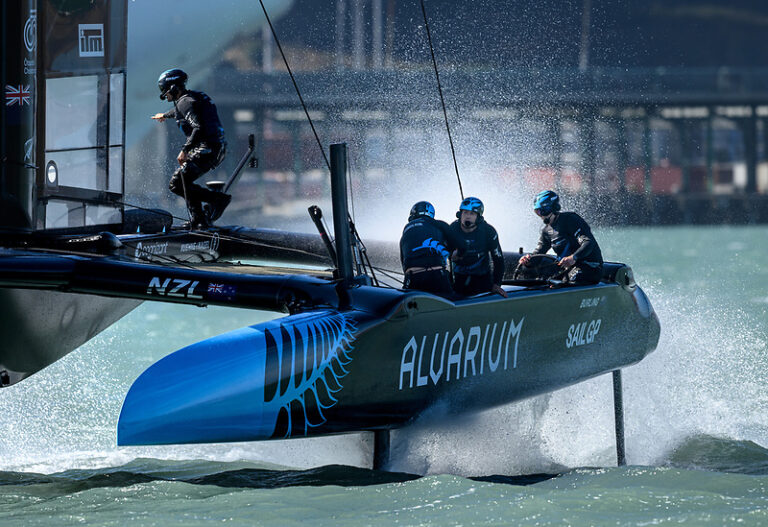
RulesDialDown368
Video of the final race of last year’s America’s Cup match was watched by thousands of sailors. The confrontation between Alinghi and Emirates Team New Zealand (ETNZ) on the approach to the windward mark was studied closely and has resulted in questions from several readers about the rules involved. In addition, Dave Perry’s report on the incident increased interest in it (see “The Dial Down” in Sailing World, September 2007, p. 43).
First, let’s review the facts. We have an unusually complete and accurate record of the relative positions of the two boats from Live Sailing’s animation of the race. The diagram above shows that record. Initially, both boats were closehauled on starboard tack with ETNZ ahead and to leeward of Alinghi, but not far enough ahead to be able to tack and cross. ETNZ tacked with the intent of bearing off and ducking Alinghi’s stern. As ETNZ was tacking onto port, Alinghi “dialed down” from a closehauled course almost to a beam reach. Alinghi then held her course for about 7 seconds during which time ETNZ bore off to a broad reach. At the last position shown in the diagram the closing speed of the boats was over 20 knots and they were less than two lengths apart. Seconds later, what might well have been a very serious collision was averted by Alinghi luffing and ETNZ continuing to bear away. The boats passed within a length of each other. Alinghi protested and the umpires gave a penalty to ETNZ.
After seeing the video, several fleet racers stated that they believe Alinghi’s maneuver was a dangerous one that the rules should not allow. My purpose this month is to compare the rules that you would need to know had this incident occurred in a fleet race with the rules that the crews of ETNZ and Alinghi needed to heed for their match race.
Here are the rules that would have been important if this incident had occurred in a fleet race. After ETNZ passed head to wind, right of way shifted to Alinghi. ETNZ was required to keep clear of Alinghi, first by Rule 13 and, after she bore off to a closehauled course, by Rule 10. During that time, both parts of Rule 16 would have limited the course changes that Alinghi, the right-of-way boat, was permitted to make. Rule 16.1 required Alinghi to give ETNZ room to keep clear when she changed course, and, in addition because ETNZ was sailing to keep clear by passing astern of Alinghi, Rule 16.2 would have required Alinghi not to change course if “as a result [ETNZ] would immediately need to change course to continue keeping clear.” In addition, Rule 14, Avoiding Contact, applied to both boats. As I will discuss below, ISAF Cases 21 and 103 are helpful in analyzing incidents like this.
In a match race, the rules of Appendix C apply and “take precedence over any conflicting rule in [Part 2]” (see “Appendices” in the Introduction to the rulebook). Match Racing Rule C2.5 deletes Rule 16.2, and so its added protection was not available to ETNZ. However, Rules 10, 13 and 16.1 did apply in the match race. In addition to Cases 21 and 103, which apply to all racing, Match Racing Call “UMP 20” was also relevant. This call has two parts: (1) It interprets, just for match racing, the meaning of “seamanlike way” as used in the definition room. (2) It states that, in a match-racing incident like this one, if the starboard-tack boat were to “dial down” to a course below a beam reach she would break Rule 16.1 because she would not give the port-tack boat “space to maneuver in a seamanlike way.”
Now let’s apply the match-racing rules to the incident to see why the umpires penalized ETNZ and not Alinghi. At the position of the boats shown in the diagram they were charging toward one another and, had they held their courses, were only 3 or 4 seconds from a devastating collision. Just after that position, Alinghi’s crew certainly needed to “take avoiding action” (see the definition Keep Clear) and did so by luffing. ETNZ continued to bear away, and the boats passed within a length of each other. Certainly, at the moment that Alinghi luffed, ETNZ broke Rule 10 by failing to keep clear. But did Alinghi break any rule? While ETNZ was turning, Alinghi bore off and then held her course for 7 seconds. Alinghi complied with Rule 14 by avoiding contact. However, when she bore off, did her course change give ETNZ room to keep clear as required by Rule 16.1?
To answer this question we need to understand some important and unique aspects of match racing, which in effect give the term room an interpretation that is different from its interpretation in fleet racing. The definition of room is, “The space a boat needs in the existing conditions while manoeuvring promptly in a seamanlike way.” Call UMP 20’s first part tells us how the phrase “in a seamanlike way” should be interpreted for match racing. It states: “Actions that are not seamanlike in a fleet of many boats may be considered seamanlike in a situation with only two boats. Thus, in match racing some maneuvers might be considered normal that would be considered abnormal in other racing . . . Any maneuver, however, that puts a boat or her crew at unreasonable risk of damage is unseamanlike.” (You can find Call UMP 20 in The Call Book for Match Racing on the ISAF website, www.sailing.org.)
ISAF Cases 21 and 103 interpret “in a seamanlike way.” Case 21 states a boat owed room must be given enough space so that she is not required to make “extraordinary or abnormal maneuvers to keep clear.” Case 103 adds that “seamanlike way” refers to “boat handling that can reasonably be expected from a competent, but not expert, crew.”
I asked an umpire with extensive experience in match races between America’s Cup Class boats how he characterized the differences in the meaning of “seamanlike way” between match racing and fleet racing. He pointed me to Call UMP 20 and then added that in match racing, as contrasted with fleet racing, there is a standard set of “moves” that are known and practiced by competent crews.
Assuming that the boat obligated to give room does so while making one of the standard moves, then that move can be made in closer quarters and leave less time for response than might be allowed for the same move in a fleet race. In a fleet race the moves and counter moves are not so well scripted and the attention of a boat obligated to keep clear is not focused on just one boat, to the exclusion of the other boats in the fleet.
Let’s get back to whether Alinghi broke Rule 16.1. The umpires ruled that she did not, and that seems correct to me. After Alinghi stopped turning and began to sail a steady course, ETNZ could have kept clear by not continuing to bear away, in which case she easily would have been able to pass well to windward of Alinghi.
What if this incident had occurred in a fleet race and ended up in the protest room? I think that the decision might well have been different. Prior to ETNZ’s tack, it was clear to both crews that she could not tack and sail across Alinghi’s bow. Therefore, when ETNZ began to tack, it should have been obvious to Alinghi that ETNZ was sailing to pass astern of Alinghi. ETNZ’s crew would have no reason to expect the “move” that Alinghi made when she bore off almost to a beam reach, nor would they be focusing their attention exclusively on Alinghi, to the exclusion of other boats. Early in her tack ETNZ was keeping clear of Alinghi and sailing to pass astern of her. When ETNZ first saw that Alinghi had borne away substantially, she would have immediately needed to begin to make a much tighter turn and sail much lower in order to continue keeping clear.
Therefore, Alinghi’s “dial down” would have broken Rule 16.2. (ISAF Case 92 provides another example of a breach of Rule 16.2.)
E-mail for Dick Rose may be sent to rules@sailingworld.com









